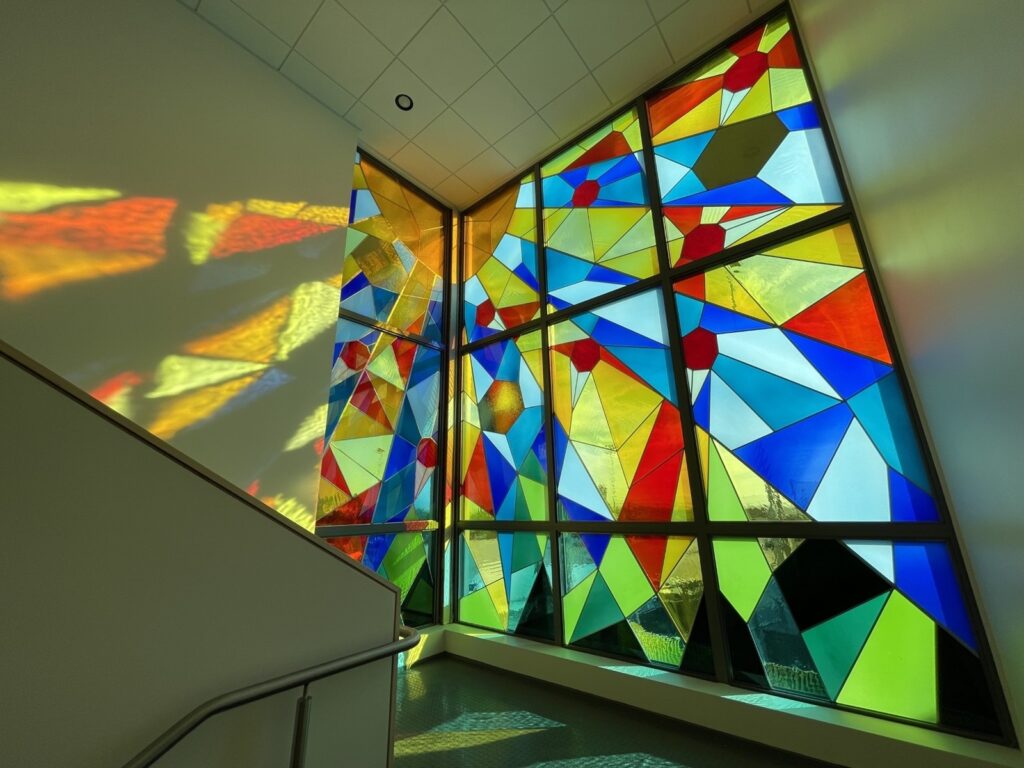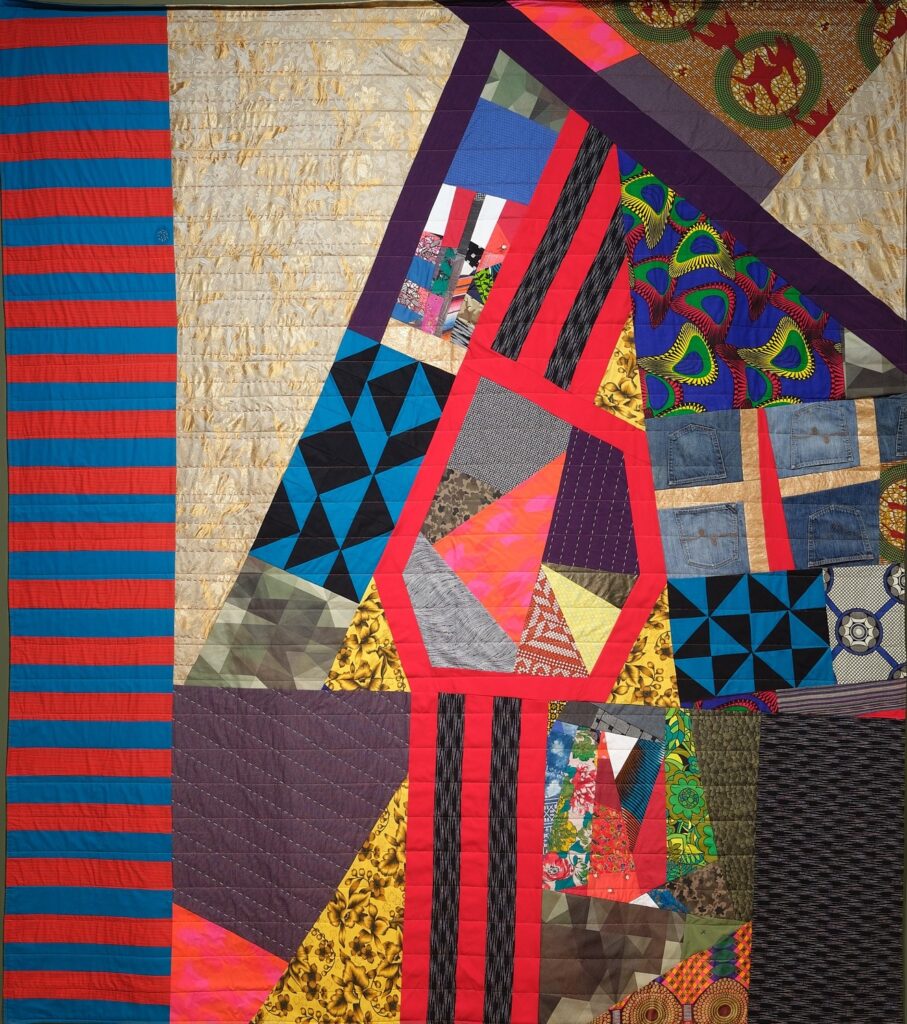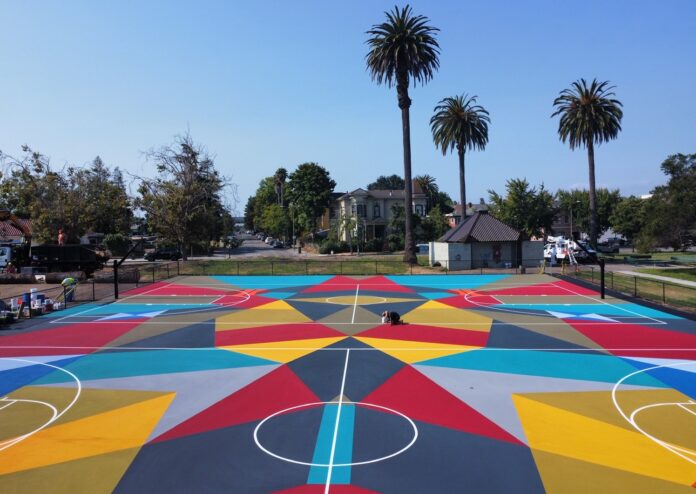Artist Adia Millett works across multiple media to explore the conceptual significance of interconnection. She describes her practice as grounded, fluid, and discerning, engaging a wide range of materials and subject matter. Whether working in fabric, glass, sculpture, painting, or on large-scale commissions, Millett accesses movement and meaning through bold geometrics and vibrant color to tell stories of cultural diversity and belonging.
For large-scale textiles and murals, Millett often uses Adobe Fresco and Procreate programs to lay out ideas, starting with a pencil drawing, photographed and imported into the app, where she tests colors, textures, and compositions before committing. These tools also serve as presentation platforms for final works. For paintings, she primarily uses acrylics, spray paint, and latex. Even in sculptural explorations like Miniatures, created from 2000–2011, Millett finds a throughline.
“What connects this work to my current practice is the use of craft and domestic imagery. My older work also explored the intersection of various cultural signifiers,” Millett told 48hills.
Raised in Pasadena, Millett moved to Berkeley in the 1990s to attend UC Berkeley and completed her MFA (2000) at California Institute of the Arts in Los Angeles. After graduate school, she moved to New York, returning to the Bay Area in 2010, which she says has always felt like home. She recently relocated to Pinole and maintains a studio near Lake Merritt in Oakland’s Jingletown neighborhood.

“The thing I love most about the Bay Area is how diverse it is—culturally, economically, ecologically, and spiritually. The lifestyle here feels liberated and casual. And saturated with color,” she said. Millett draws inspiration from the cultural diversity she was raised with. Her list of creative influences is long, but standouts include James Baldwin, Octavia Butler, Alice Coltrane, and Rosie Lee Tompkins.
“I learned at a very young age that we have the capacity to redefine ourselves and the world around us. As an artist, my process always starts with finding ways to expand our understanding of subjects such as death, identity, color, nature, privilege, jazz, etc.”
Millett says she will use any medium that speaks most adequately to a topic but is most often drawn to craft materials such as textiles, glass, and wood. “These days most of my work is painting, quilted works, and glass. The images formed through these materials are always in conversation with one another through shape, color, and texture,” Millett said.
While specific subject matter and media may vary, the common denominator is always the theme of interdependence, a constant in her work. “I mean to explore the various ways of connection we have to each other, to the earth, to our trauma, and to our ancestors,” she said.
Millett’s studio is her sanctuary. With plenty of sunlight and potted plants, she is alternately surrounded by paint containers or fabric scraps all over the floor, depending on the project she is working on.
“I usually come in, respond to emails first, then I make sure I have the appropriate clothes on. If I’m painting, the sink must be cleared out for brushes. If I’m working on a public art piece, there’s lots of sketching on big butcher paper. If I’m sewing, the iron is turned on. I often light a candle to evoke the ancestors,” Millett said.

She’s had her current studio since the start of COVID, initially living and working there before expanding her workspace to separate the two. Reflecting on her career, Millett says the path has been anything but linear.
“I started strong after graduate school when I moved to New York. I was fortunate to be included in some significant shows and find gallery representation. After eight years, the economy plummeted and I decided to come back to California. I basically had to start all over. I was teaching and doing art counseling while I began showing here in the Bay Area,” Millett said.
In 2017, she committed exclusively to making art—a decision she calls one of the hardest and best of her life.
“My fear of failure as an artist had prevented me from taking risks. Fortunately, a few galleries (Jenkins Johnson, Patricia Sweetow, State Space, and Traywick) believed in me enough to give me shows. Then in 2019, I had a big show at the California African American Museum in Los Angeles. I realized at this point that my voice was important,” Millett said.
Lately, aging has informed her process. She considers her legacy, thinking more profoundly about what she wants to leave behind when she’s gone. “The pandemic pushed me to be more concerned with this and with our natural environment, as the earth and all its elements are essentially what keeps us alive. Technology and social media have also played into my desire to create work that can speak to both the past and the future,” she said.
Large-scale public works have brought Millett into deeper collaboration with local communities. She recently installed a three-panel quilted textile at The Chase Center in Mission Bay. Her piece, Warrior’s Portal, part of her Homegrown series, stitches together fabrics from various cultures to represent the overlapping identities of the Bay Area. At Lowell Park in Oakland, she partnered with Project Backboard to transform a run-down basketball court into public art.
“The difference between a project vs. making work for a gallery exhibition is that these public works are all about listening to the community and stakeholders. In a word, collaboration,” Millett said.
The Lowell Park commission took three years to complete. Despite delays due to COVID and bureaucratic snags, Millett calls it one of the most rewarding experiences of her life. “The park transformed and the community really got on board with bringing beauty to the court. The art was titled Take Flight, and within it you can see kites, paper airplanes, and basketballs. The overall design suggests the shape of an African tribal mask,” she said.
Since taking the risk to dive into the deep end of her creative career, Millett is gaining recognition more broadly. She was one of 12 women in the April-May group show, Reunited, by the San Francisco Advocacy for the National Museum of Women in the Arts (SFNMWA) in association with and presented by California College of the Arts. In March 2025, Millett was an honoree at the KALA 2025 Art Auction Benefit in Berkeley, and in 2024, Millett was profiled in Art Journal as part of a feature on the resurgence of Black Abstraction in the arts.

Millett is currently represented by Haines Gallery in San Francisco and Galerie du Monde in Hong Kong. Her work has been exhibited in museums across the country, including The Museum of the African Diaspora (San Francisco), The Studio Museum in Harlem, The Museum of Contemporary Art of Georgia (Atlanta), and the Contemporary Arts Center New Orleans, among others.
Outside the studio, Millett spends time hiking and traveling—activities that feed her creative intention. Her ongoing goal is to create work that reminds us of the intrinsic, undeniable interconnection of all things.
“Our cultures are linked. The ability to have empathy is where beauty lies,” Millett said. “Using materials that hold history and emotion, I invite viewers to imagine fictional stories infused with truth.”
For more information, visit her website adiamillett.com and on Instagram. Watch her video on the construction of Warrior’s Portal for the Chase Center.






